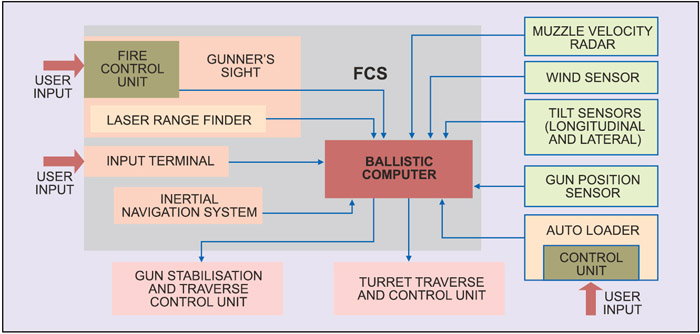
The commander, after having assigned a target to the gunner, uses his panoramic sight to locate the next target. If he has located a target even before the current firing, it is stored in the memory of the FCS. After firing and damage assessment of the target is over, the gunner can take up this new target from the FCS memory. The commander can keep on looking for new targets through his sight and, if required, he can take over the engagement from the gunner and himself shoot on sudden threats. In the past such an engagement sequence would have been a dream! The modern tanks are said to be capable of typically engaging around six different targets within 35 seconds while on the move.
Apart from these commander’s and gunner’s sights, the tank driver also has a day/night-capable sight. With that he can drive the tank as efficiently during nights as he does during day; the driver needs not to even switch on the headlights to drive. In some very latest tanks, rear facing cameras feed imagery to the driver who can easily reverse the tank, or manoeuvre into the confined spaces of a transport aircraft easily.
Fire control system of SPG
The FCS of a self-propelled gun also performs more or less like a tank’s FCS. It executes the gun laying and stabilisation job but does not have the complexity of engaging a moving target or firing the gun on the move. For an SPG, the targets are stationary and the gun is also stationary. But what is important is the number of shells rained accurately on a target situated at long ranges. Because once artillery shells start coming, the enemy will track their trajectory through their weapon locating radars and find out locations of the guns. Then the enemy will not sit idle. They will try to neutralise the SPGs with their own guns in what is called as ‘counter battery fire’ in artillery parlance. So, to evade counter battery fire, the SPGs are required to bombard heavily and then move away rapidly in what is called as ‘shoot and scoot’ tactics.
But laying the gun accurately has not been easy. A fraction of a radian deviation will cause the shell to deviate and land way away from the target. (A trigonometric milliradian (mrad) is the angle formed when the length of a circular arc equals 1/1000 of the radius of the circle.) The place where the SPG stands, its elevation/depression, tilt, etc affect the gun’s alignment. During firing, the gun also moves backwards due to recoil and needs to be readjusted for every shot fired. All these complexities are met by the modern electronic fire control systems.
The first requirement to fire at an unseen target is that the FCS must know its geographical position. So it derives its own position with respect to ‘true north’ through a navigation system based on an inertial navigation system. Often this navigation system’s output is added with a GPS ‘topping’ for accurate derivation of coordinates. When the target’s geographical coordinates, altitude and other environmental parameters are entered into the FCS, it finds out how the target is aligned with it and in which direction. It also takes other inputs like altitude of the current position, tilt angles if any, wind speed, etc. With that, it transforms the positional information into firing solution, which tells how the gun has to be aligned. Accordingly, it actuates the electrical drives and lays the gun. In World War II era photographs we often see the gunners working with a bare chest, beaten by sun and dirt. To an extent, we can comfortably say that modern-day guns can be fired without losing the crease of gunners’ uniforms. Not only that, the enemy is at the MRSI of these guns. We know mercy, but what is this MRSI?
MRSI stands for multiple round simultaneous impacts. As these SPGs fire at a long-range target, the shell reaches the target in a parabolic trajectory. If a shell is fired by slightly depressing the gun, the shell’s trajectory will have a shallow angle and it will reach the target quicker than the previous shell. Using this technique, it is possible for the SPG to rapidly fire some five shells by progressively depressing the gun for each firing. Thus the shells will land on the target at almost the same time and can pepper the target. This is what MRSI is for.






